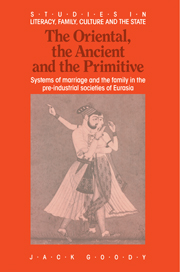 The Oriental, the Ancient and the Primitive
The Oriental, the Ancient and the Primitive PART II - INDIA
Published online by Cambridge University Press: 09 January 2010
Summary
Like China, India is a vast and populous area of the world with many internally shared cultural characteristics, largely the result of its religious heritage (for no over-all political unity existed until recently), although this ritual unity was supplemented by local cults and was broken on the national level as early as the fifth century BC with the development of Buddhism and much later the advent of Islam. Buddhism largely disappeared except in SriLanka, but Jainism and Judaism, Christianity and Islam from the West, all made their appearance to supplement local differentiation, even if Hinduism reasserted itself throughout. Some of the common features of marriage and the family are particular to the sub-continent, especially the exceptionally early age of marriage, particularly of girls, while others display a broad similarity with the mechanisms of continuity we have found in China. At the same time it is important to stress the internal differences, whether of town and country, of tribe and caste, of upper and lower and, most importantly, of religion and region. We shall try to specify some of these features and to link them, where relevant, with other differences in the social system, taking into account the past as it may have influenced the present.
In the context of the general continental similarities that are brought out by the often implicit contrast with Africa, we want to explore the difference between upper and lower in the hierarchy of caste and class, between North and South India, as well as that between India and China.
- Type
- Chapter
- Information
- The Oriental, the Ancient and the PrimitiveSystems of Marriage and the Family in the Pre-Industrial Societies of Eurasia, pp. 155 - 159Publisher: Cambridge University PressPrint publication year: 1990
